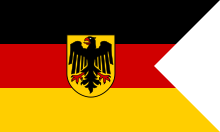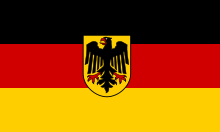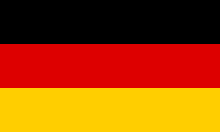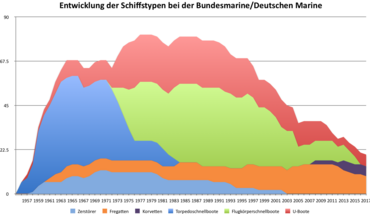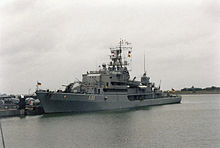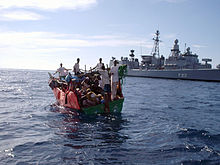German Navy
|
marine |
|
|---|---|
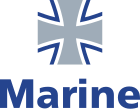
|
|
| lineup | January 2, 1956 |
| Country |
|
| armed forces |
|
| Type |
Armed Forces ( Naval Forces ) |
| outline |
|
| strength | 16,217 (November 2021) of which women: 1,706 |
| insinuation |
|
| Headquarters Naval Command |
|
| management | |
| Deputy Inspector of the Navy | Rear Admiral Jan Christian Kaack |
With around 16,000 soldiers , the Navy is the smallest of the three branches of the Bundeswehr . In addition to the designation Navy , the Navy has used the self-designation Deutsche Marine since 1995 to distinguish it from foreign naval forces in an international context ; before 1995 the self-designation Bundesmarine was used to distinguish it from the East German Navy . It is led by the Inspector of the Navy .
story
Former German naval forces

Individual former German states had their own naval forces, which were mostly small by international standards. Examples were the Prussian , Austrian or Schleswig-Holstein Navy . The Imperial Fleet (from 1848) and the Navy of the North German Confederation (from 1867) were the first steps towards establishing a joint naval force . After the founding of the empire , the latter became the Imperial Navy in 1872 . The German naval forces were known as the Reichsmarine (until 1921 Provisional Reichsmarine ) after the revolution , in which German sailors were actively involved, and in Nazi Germany from 1935 as the Kriegsmarine . After the Second World War , the naval forces were almost completely destroyed. In 1952, the German Democratic Republic began to set up the People's Police Sea , which was transferred to the People 's Navy in 1956 (referred to as the Naval Forces of the NVA until 1960 ). In the Federal Republic of Germany , the first plans for the Navy of the German Armed Forces began at about the same time .
Federal Navy
Today's navy was rebuilt after the Second World War as part of Germany's rearmament as part of the Bundeswehr. It differs from the traditions of former German naval forces. Until 1995, the self-designation Bundesmarine was also common for them. Originally, the designation was simply marine without any additions. During the East-West conflict it had the following main tasks, which it had to fulfill together with the NATO allies and above all with the Danish Navy : It was to protect the approaches to the Baltic Sea against occupation by the Warsaw Pact and thus those in the Baltic Sea include existing Warsaw Pact naval forces. In the North Sea and North Atlantic , it was intended to protect Allied reinforcement transports to Europe.
Reorganization after reunification
In the legal sense, German unity in 1990 was not achieved through the unification of two states, but through the accession of the five new federal states and the reunified Berlin to the Federal Republic of Germany . Therefore, personnel and, to a lesser extent, material from the disbanded People 's Navy was taken over by the Bundeswehr. Despite the institutional continuity, the leadership of the Navy decided in 1995 to no longer use the previously common designation Bundesmarine , but instead to use the term Navy from now on or, in order to distinguish it from foreign navies in an international context, the term German Navy .
After 1990, the Navy initially retained its previous structure, but, like the entire Bundeswehr, was gradually reduced in size. Until the end of 1994, the provisions of the Two Plus Four Treaty did not allow NATO forces to be stationed on the territory of the former GDR. For this reason, the parts of the former People's Navy that were initially to be kept in service were grouped together in a separate naval command in Rostock , which was initially subordinate to the Bundeswehr Command East in Strausberg .
From 1995, a uniform naval structure was created and the forces stationed in the accession area assigned to NATO (roughly: 'shown as available'). The naval command east was dissolved, instead some new departments were set up in the accession area (naval section command east, naval engineering school), others were relocated there from the west ( fast boat flotilla , naval office ).
The organization of the Navy only began to change fundamentally with the Bundeswehr reform initiated by Defense Minister Rudolf Scharping in 2000. In the meantime, the step-by-step Bundeswehr reforms that have been customary up to now have been replaced by a continuous transformation of the Bundeswehr , in which the Navy is integrated.
The number of smaller ships and boats specifically earmarked for Baltic warfare before 1990 will be further reduced. A smaller number of larger vehicles of different types will be procured for this purpose. At the same time, the number of marines will be reduced to about 25,000. In relation to the other branches of the armed forces, however, the proportion of marines in the Bundeswehr has grown from around 7.7% before 1990 to around 10% in the future.
The Center of Excellence for Operations in Confined and Shallow Waters was set up at Flotilla 1 in Kiel in 2007 and officially accredited by NATO in 2009 in order to better bring experiences and ideas for operations close to the coast to NATO and to be able to develop them further together .
At the head of the Navy was the Inspector of the Navy in the Federal Ministry of Defence . As the military superior of his branch of the armed forces, he reported directly to the Federal Minister of Defence. The inspector was supported by the Naval Staff , a department of the Ministry in Bonn. The Navy consisted of two command areas, the Fleet and the Navy Office.
As before 1990, the Navy remains part of the NATO command structure, which in turn has adapted to the changes after the end of the East-West conflict . Ships and boats take part in the permanent NATO task forces, which are also led by German naval officers in rotation with other nations.
Realignment of the Bundeswehr
The realignment of the Bundeswehr , which began in 2010, is leading to fundamental changes in the Navy. This is particularly evident in the complete restructuring of the management organization with the elimination of the naval command and control staff in the Federal Ministry of Defense . As of October 1, 2012, the Naval Operations Staff , Fleet Command and Naval Office were dissolved. At the same time, the naval command was reorganized. The official line-up appeal took place on October 9, 2012 in Rostock .
On September 27, 2016, the 5th minesweeper squadron was decommissioned and the support squadron was commissioned in Kiel . On November 16, 2016, the last Schnellbootgeschwader was decommissioned in Warnemünde.
order
The Navy contributes to its tasks as set out in the applicable defense policy guidelines of the Federal Minister of Defence :
"The Bundeswehr, as an instrument of a comprehensive security and defense policy, fulfills its mission:
The Bundeswehr
- protects Germany and its citizens,
- ensures Germany's ability to act in foreign policy,
- contributes to the defense of the allies,
- contributes to stability and partnership in the international framework and
- promotes multinational cooperation and European integration.
Against this background, the Bundeswehr performs the following interlocking tasks:
- National defense as alliance defense within the framework of the North Atlantic Alliance;
- international conflict prevention and crisis management – including the fight against international terrorism;
- Participation in military tasks within the framework of the EU's common security and defense policy;
- Contributions to homeland security, d. H. Defense tasks on German sovereign territory and administrative assistance in cases of natural disasters and serious accidents, to protect critical infrastructure and in the event of an internal emergency;
- rescue and evacuation and hostage rescue abroad;
- Partnership and cooperation as part of multinational integration and global security cooperation in the understanding of modern defense diplomacy;
- humanitarian aid abroad.”
After 1990, the tasks of the Bundeswehr shifted from national defense during the "Cold War" to international conflict prevention and crisis management missions outside Germany ("Armee im Einsatz").
The Inspector of the Navy specifies in his annual instructions how these orders are implemented in the Navy.
According to this, the Navy is to take part in foreign missions with a focus on joint operations. In accordance with the “sea basis” concept, it is intended to support other armed forces with its resources from the sea so that the high seas can be used as a base for military operations. For example, the Sachsen-class air defense frigates can protect land units deployed near the coast against air attacks.
In addition, as part of the task of "protecting Germany and its citizens", the navy is to protect the sea routes against asymmetric threats and thus contribute to the security of German maritime trade .
As a contribution to the task of "homeland security", the Navy participates in the permanent SAR service in the German coastal area.
organization and leadership
At the head of the Navy is the Inspector of the Navy at Naval Command . As the military superior of his branch of the armed forces, he reports to the Inspector General of the German Armed Forces. His deputy bears the designation Deputy Inspector of the Navy and Commander of the Fleet and Support Forces .
Subordinate forces of the Navy
The forces subordinate to the naval command are subordinate to individual department heads of the naval command. There are assigned:
Head of Deployment
-
 Operations Flotilla 1 (EinsFltl 1) in Kiel
Operations Flotilla 1 (EinsFltl 1) in Kiel
-
 Operational flotilla 2 (EinsFltl 2) in Wilhelmshaven
Operational flotilla 2 (EinsFltl 2) in Wilhelmshaven -
 Naval Aviation Command (MFlgKdo) in Nordholz
Naval Aviation Command (MFlgKdo) in Nordholz
-
 Deployment training center for marine damage control (EAZS) in Neustadt in Holstein
Deployment training center for marine damage control (EAZS) in Neustadt in Holstein
-
 Naval Shipping Control Center (MSLtSt) in Hamburg
Naval Shipping Control Center (MSLtSt) in Hamburg
Head of Human Resources, Training, Organisation
-
 Naval Academy Mürwik (MSM) in Flensburg - Mürwik
Naval Academy Mürwik (MSM) in Flensburg - Mürwik
- Sail training ship Gorch Fock , subordinate to MSM, with homeport Kiel
-
 Naval NCO School (MUS) in Plön
Naval NCO School (MUS) in Plön
-
 Naval Operations School (MOS) in Bremerhaven
Naval Operations School (MOS) in Bremerhaven
-
 Naval Engineering School (MTS) in Parow
Naval Engineering School (MTS) in Parow
Head of Operations Support
-
 Naval Support Command (MUKdo) in Wilhelmshaven
Naval Support Command (MUKdo) in Wilhelmshaven
Head of the Naval Medical Department and Admiral Physician of the Navy
-
 Maritime Medicine Institute of the Navy (SchiffMedInstM) in Kronshagen
Maritime Medicine Institute of the Navy (SchiffMedInstM) in Kronshagen
equipment
ships and boats
- frigates
-
11 frigates
- 3 Baden-Württemberg class (125) (currently on the way, target size four units)
- 3 Saxony -class (124)
- 4 Brandenburg -class (123)
- 1 Bremen - class (122) (to be decommissioned by [obsolete] 2021 and replaced by four Baden-Württemberg-class (125) frigates )
- Corvette, submarine
-
5 corvettes
- Braunschweig -class (130) (5 more ordered, target size ten units)
- 6 submarines
-
12 anti-mine vehicles
- 2 hollow rod steering boats Ensdorf class (352) (serve as troop recruitment platforms)
- 10 Frankenthal - class minesweepers (332) (incl. two units that can also be used as diving boats)
- support units
-
20 auxiliary ships
- Sailing training ship Gorch Fock
- 3 Berlin -class task force supplies (702)
- 2 Rhön -class fuel transporters (704)
- 6 tenders Elbe -class (404)
- 2 sea tugs Wangerooge -class (722B)
- 1 Fehmarn -class salvage tug (720)
- 1 Barbe -class multipurpose landing craft (520)
- 3 fleet service boats Oste -class (423)
- 1 research vessel Planet (751)
aircraft
- aircraft
-
6 planes
- 4 P-3C Orion maritime patrol aircraft (originally 8 machines)
- 2 Dornier 228 LM oil reconnaissance aircraft
-
48 helicopters
- 14 Sea King Mk41
- 22 Sea Lynx Mk 88A
- 12 NH90 NTH
naval bases
-
Wilhelmshaven ( Naval Base Heppenser Groden )
- Frigates, supply ships
-
Eckernförde ( Naval Base Eckernförde )
- Submarines, fleet service boats, supply ships, Special Forces Navy Command, Sea Battalion
-
Kiel ( Naval Base Kiel )
- Supply ships, anti-mine units, sail training ship Gorch Fock
-
Rostock ( Warnemünde Naval Base )
- corvettes, convoy ships
-
Nordholz ( Naval Aviation Command )
- Helicopters and propeller planes
transmitters
- Naval radio station Rhauderfehn in Rhauderfehn / Saterland
- Marlow Naval Radio Station in Marlow
- Marine radio station Neuharlingersiel in Neuharlingersiel
- Marine radio station Hürup in Hürup
Others
The Navy also operates SAR service helicopter bases for aircraft in Germany on Heligoland and at the Warnemünde naval base .
In Berlin , the Navy maintains a barge named Marine 1 for representation purposes of the Federal Ministry of Defence . The 4th company of the guard battalion at the Federal Ministry of Defense at the Federal Ministry of Defense is provided by the Navy.
staff

Around 16,000 soldiers are active in the Navy itself, others wearing naval uniforms in the Federal Ministry of Defense and in the other organizational areas of the Bundeswehr , above all in the armed forces base and the central medical service . Some of the soldiers serve permanently on seagoing units. In the Navy there are professional soldiers , temporary soldiers and conscripts doing military service voluntarily .
The rank designations in the Navy differ from those of the other branches of the Bundeswehr, but follow the same system. The enlisted men and non-commissioned officers receive specialized training in different assignment series at naval schools and in some cases in other parts of the Bundeswehr. High- performing non-commissioned officers can be trained to become an officer in the military service and, in individual cases, an officer in the troop service . All officers receive training at the Mürwik Naval Academy . With a few exceptions, the officers of the military service receive a degree at a university of the Federal Armed Forces .
In addition to the soldiers, civilian employees also work in the Navy. Some of the Navy's auxiliary ships , such as the fuel transporter, are partly or exclusively manned by civilian personnel.
Maintaining the tradition and customs of the Navy gives the members a special sense of belonging to their service.
Major associations of Navy personnel and alumni are
As part of the realignment of the Bundeswehr , the Federal Ministry of Defense is planning to reduce the number of active soldiers in the Navy to a maximum of 13,850. Of these, 12,550 are said to be career soldiers and between 500 and 1,250 volunteers for military service .
armaments project
The Navy is currently pursuing the following major armaments projects:
- 18 NTH "Sea Lion" naval transport helicopters (replacement for the 21 Sea King Mk 41 ; incoming since 2019)
- 4 125 -class frigates (replacement for the Bremen-class (122) ships ; 3 commissioned; one unit on the way)
- 5 additional class 130 corvettes ( ordered ; delivery planned from 2023 to 2025)
- 2 fuel transporter class 707 (ordered; replacement for the Rhön class (704) ; delivery planned from 2024)
- 31 multi-role frigate helicopters (MRFH) "Sea Tiger" (ordered; replacement for the 22 Sea Lynx MK 88A ; arrival planned from 2025)
- 5 Boeing P-8A "Poseidon" maritime patrol aircraft (ordered; replacement for the 4 P-3C Orion ; arrival planned for the mid-2020s)
- Procurement of the NSM anti-ship missiles for the F124 , F125 and F126 frigates . On the frigates F124 and F125 as a replacement for the AGM-84 Harpoon (ordered; delivery planned from the mid-2020s)
- 3 fleet service boats class 424 (ordered; replacement for the Oste class (423) , arrival planned from 2025 to 2027)
- 4 (+2 optional) units of the F126 class (ordered; multi-purpose frigate; arrival planned from 2027)
- 6 tenders with limited management capabilities for smaller units (replacement for the Elbe class (404) ; addition planned from 2029)
- 2 additional submarines ( submarine class 212 CD ), which are based on the class 212A in their capabilities and are procured together with Norway (ordered; arrival planned for 2032 and 2034)
- 6 127 class frigates to be developed and procured together with the Dutch Navy (there as a replacement for the De Zeven Provinciën class frigates ). (Replacement for the Sachsen-Class (124) ; Inflow planned from 2032)
Also planned is the introduction of new minesweepers, the EuroMALE reconnaissance drone and 9 (+12 optional) task boats for the sea battalion . In addition, the replacement of (port) operating and training ships is pending, whereby leasing models are also being considered here.
Navy operations since 1990
As early as the first Gulf War in 1987, the German Navy operated regularly in the Mediterranean to support the allies in this region, which was becoming increasingly important in terms of security policy. Immediately after reunification, an intensive debate began in Germany about the deployment of the Bundeswehr outside the NATO treaty area (“out-of-area debate”). It was spurred on by the deployment of German forces during the Gulf conflict that followed Iraq's occupation of Kuwait on August 2, 1990. The Navy was involved in these operations with considerable forces ( see below ).
The legal issues surrounding armed deployments abroad were largely clarified by a judgment of the Federal Constitutional Court on July 12, 1994, which ended the out-of-area debate. However, there is still no regulation for the use of the Navy to combat the proliferation of weapons of mass destruction, drug trafficking , human trafficking and piracy on the high seas . Due to the domestic legal situation, the Navy can only take part in corresponding operations of allied states with restrictions.
On the other hand, the navy was commissioned with armed operations in accordance with the judgment of the Federal Constitutional Court from the outset. Within the framework of NATO's permanent task forces, the Navy also carries out surveillance and presence tasks in important sea areas that do not fall under the formal concept of armed deployment. In addition, marines are involved in almost all other deployments of the Bundeswehr, who serve in the Bundeswehr's central medical service and the armed forces base or are seconded by the navy for special tasks.
The missions have confronted the Navy, like other parts of the Bundeswehr, with new challenges. One of the reasons for this is that the existing ships are designed for Cold War tasks. The new tasks demanded new equipment (e.g. small-caliber machine guns on frigates) and new procedures. The hot climate at the Horn of Africa led z. B. to technical problems with the cooling of the living quarters and the ship's diesel. In this respect, the missions are associated with high physical stress for the crews. One of the new procedures was to transport smaller vehicles, in this case speedboats, to the operational area on board a dock ship rather than on their own keel in order to protect the material. The operational experience flows into the designs for new ships.
Prior to the start of the Lebanon operation, the Navy routinely had three frigates, two anti-mine vehicles, a submarine, one or two support ships and elements of the naval aviation force with approximately 1000 soldiers in operations including involvement with the Standing NATO Maritime Groups/NRF. With the Lebanon mission, the number of personnel involved rose to around 1,700 at times.
Operational stress and lack of financial resources have led to restrictions on the operational status, especially in the area of naval aviation, so that not enough helicopters are available for current operations. The availability of the floating units is also limited by these circumstances.
The operational and training association (EAV) serves as an operational reserve for unforeseen operations, and its primary task is the training of officer candidates . The SAV has already been used for several operations.
Operations related to the 1990-1991 Gulf War
After Iraq occupied Kuwait on August 2, 1990, Bundeswehr forces were deployed to the Mediterranean Sea and Turkey to reinforce NATO's southern flank . The navy took part with a mine countermeasures unit ( Operation Südflanke ), with destroyers , frigates , auxiliary ships and some aircraft. At times there were up to 20 ships and boats in the Mediterranean. After the end of hostilities in the spring of 1991, the mine countermeasures association took part in clearing mines in the Persian Gulf , which is considered to be the Bundeswehr's first out-of-area operation.
Missions in the Adriatic Sea since 1992
After the outbreak of the first armed conflicts in the former Yugoslavia as a result of the 25 June 1991 declaration of independence of Slovenia and Croatia and the subsequent 10-day war in Slovenia, NATO began surveillance operations in the Adriatic Sea in 1992 . Ships and aircraft of the German Navy were also involved. The German Navy's first ship in the Adriatic was the destroyer Bayern . Based on various United Nations resolutions , the surveillance operation became the embargo operation Operation Sharp Guard . German participation in this was one of the subjects of the aforementioned proceedings before the Federal Constitutional Court. Only after its completion in 1994 could the Navy fully participate in the Adriatic operations. On the one hand, the operation served to prevent arms deliveries to the entire former Yugoslavia, on the other hand, a trade embargo against the rest of Yugoslavia was to be enforced in order to force it to settle the conflict peacefully in Bosnia and Herzegovina .
On June 30, 1995, the Federal Government decided to take part in Operation Deliberate Force to protect the UNPROFOR troops in Bosnia and Herzegovina with units from all branches of the armed forces . In addition to two Bréguet Atlantic reconnaissance aircraft , the Navy should, if necessary, send a mine countermeasures unit and a speedboat unit to the Adriatic Sea. Of these forces, only the two maritime reconnaissance aircraft were activated.
Even after the conclusion of Operation SHARP GUARD in 1996, the Navy - mostly as part of NATO formations - remained present with ships and aircraft in the Adriatic. In March 1997, for example, she took part in the German Operation Libelle to evacuate German citizens from Albania . Ship patrols in the Adriatic continued during the Kosovo War, and after the conflict ended in 1999, the Navy participated in the removal of munitions dumped in the Adriatic.

Somalia 1994
In December 1993, the Federal Cabinet decided to end the support mission of the German army in Somalia , which had been running since July, by the end of March 1994. Due to the rapidly deteriorating security situation, the army contingent was not repatriated by air transport. Until February 1994, as part of Operation Southern Cross , the Navy evacuated around 1,700 soldiers with frigates and supply ships in several transports from Mogadishu to Mombasa and Djibouti .
Fight against international terrorism since 2001

The Bundeswehr has been deployed in the fight against international terrorism since 2001 . A naval contingent patrolled the Horn of Africa sea area from early 2002 to summer 2010 from bases in Djibouti as part of the international Operation Enduring Freedom . In the initial phase, three frigates, five speedboats, several auxiliary ships, maritime reconnaissance aircraft and helicopters with around 1,500 soldiers were involved. This was the Navy's largest deployment to date since 1990. The scope has since been significantly reduced. The naval contingent thereafter consisted of a frigate, temporarily a supply ship and a small base in Djibouti, which survives and supports the units of Operation Atalanta .
The Navy has also been involved in NATO's Active Endeavor operation in the Mediterranean since late 2001 .
Lebanon since 2006
After the end of the Lebanon war in 2006, a naval unit belonging to the United Nations Interim Force in Lebanon (UNIFIL) was set up, in which the Navy has been involved since October 2006. From October 2006 to February 2008 this association was led by a German admiral . The German part initially consisted of two frigates, four speedboats and two auxiliary ships. Since handing over the leadership task, he has been reduced to one frigate, two boats ( Schnellboote or minesweepers) and a tender.
Fighting piracy since 2008
Since the start of Operation Enduring Freedom in 2002, German warships have repeatedly been confronted with pirate attacks on merchant ships. She was not tasked with fighting piracy, but in many cases the appearance of a warship was enough to prompt the pirates to abandon their attack. The threat to shipping from piracy off the coast of Somalia , which has increased by leaps and bounds since the beginning of 2008, is now to be combated in a targeted manner through various military operations by NATO, the EU and individual states. The Navy initially made the frigate Karlsruhe available for use in the EU operation Atalanta . The mandate limit, including those deployed to combat piracy as part of Operation Enduring, is 1,400 troops. The mission started on December 19, 2008.
Evacuation operation off Libya in 2011
At the end of February 2011, the Federal Ministry of Defense dispatched the frigates Brandenburg , Rhineland-Palatinate and the task force supply ship Berlin with two helicopters SeaKing off the coast of Libya to stand by for the evacuation of foreign nationals who are to be brought to safety because of the uprising there . The ships with around 600 soldiers on board belong to the operational and training unit of the Navy and were already in the Mediterranean. On March 7, 2011, about 450 refugees were taken on board and transported from Tunisia to Egypt.
Destruction of Syrian chemical weapons in the Mediterranean Sea in 2014-2015
On April 9, 2014, the Bundestag gave the mandate to protect the US special purpose ship Cape Ray in the eastern Mediterranean, on which Syrian chemical weapons were to be destroyed. The frigates Augsburg , Hamburg and Schleswig-Holstein were successively used for this task . The mission ended at the end of April 2015.
Refugee rescue and anti-smuggling in the Mediterranean 2015 to 2020
Since April 2015, the Navy has been involved in rescuing refugees in the Mediterranean. Two larger naval units such as frigates and supply ships are used for this. The first two ships were the frigate Hessen and the Einsatzgruppenversorger Berlin . Since June 2015, the deployed forces have been involved in the fight against human smuggling as part of the European Union Naval Force – Mediterranean .
From February to June 2016, the Navy also participated in maritime surveillance in the Aegean as part of the Standing NATO Maritime Group 2 under the leadership of German Admiral Jörg Klein and later on board the task force supply ship Bonn . In doing so, it supported the European border agency Frontex in combating people smuggling in this sea area.
Support to the French Navy in the Persian Gulf January to March 2016
As the Bundestag decided on December 4, 2015, the frigate Augsburg will be stationed in the Persian Gulf to protect the French aircraft carrier Charles de Gaulle . This in turn offers a mobile air force base in the fight against the terrorist militia “ Islamic State ”. The mission ended in March 2016.
Operation Sea Guardian since 2016
Operation Sea Guardian is a NATO operation in the Mediterranean Sea . It was decided at the NATO summit in Warsaw in June 2016 as a follow-up operation to Operation Active Endeavor and began on November 9, 2016. The German Bundestag approved the Bundeswehr's participation on September 29, 2016 and extended it several times, most recently on March 22, 2018 until March 31, 2019.
Operation Irini to enforce an arms embargo since 2020
In 2020, the European Union 's Operation Irini gave the Navy a mandate to enforce the United Nations arms embargo on civil-war Libya by sea.
See also
- List of German admirals
- List of associations and departments of the German Navy
- List of Bundeswehr submarines
- Mine Diver Company
- combat swimmer
- List of Naval Forces
literature
- Siegfried Breyer, Gerhard Koop: The Ships, Vehicles and Aircraft of the German Navy from 1956 to the Present . Bernard & Graefe, Bonn 1978, ISBN 3-7637-5155-6 .
- Konrad Ehrensberger : 100 Years of Organization of the German Navy, 1890–1990. Imperial Navy, Imperial Navy, Navy, Federal Navy . Bernard & Graefe, Bonn 1993, ISBN 3-7637-5913-1 .
- Hannes Ewerth, Peter Neumann: German Navy . 2nd edition, mediator, Hamburg [u. a.] 2007, ISBN 978-3-8132-0879-5 .
- Sigurd Hess , Guntram Schulze-Wegener , Dieter Stockfisch , Heinrich Walle (eds.): 50 Years of the German Navy in Pictures . Report Verlag, Bonn 2006, ISBN 978-3-932385-25-4 .
- Sigurd Hess, Guntram Schulze-Wegener, Heinrich Walle (eds.): The Fascination of the Lake. 50 Years Navy of the Federal Republic of Germany . On behalf of the German Marine Institute, Mittler, Hamburg [u. a.] 2005, ISBN 3-8132-0838-9 .
- Werner Rahn (ed.): German navies in transition. From the symbol of national unity to the instrument of international security (= Contributions to Military History , Volume 63). Commissioned by the Military History Research Office, R. Oldenbourg, Munich 2005, ISBN 3-486-57674-7 .
- Jann M. Witt: German naval history. 1848 to present . Palm Verlag, Berlin 2015, ISBN 978-3-944594-23-1 .
- Naval Command (ed.): Naval Command: Annual Report 2021 - Facts and figures on the maritime dependency of the Federal Republic of Germany . September 2021 ( bundeswehr.de [PDF; retrieved 18 November 2021]).
web links
- Official website of the Navy
- Naval Officers Association
- German Navy Association
- German Naval Museum
- German Maritime Competence Network
itemizations
- ↑ Federal Ministry of Defence: Bundeswehr personnel numbers. January 2022, accessed 4 January 2022 (as of November 2021).
- ↑ According to a letter from the Federal Ministry of Defense from 1956 (Press and Information Center for the Navy).
- ↑ a b c d Detlef Struckhof: German Navy – press release: "Federal Navy" or "German Navy"? – What is the correct name of the smallest branch of the Bundeswehr? In: Presseportal.de . Press and Information Center Navy, 30 April 2009, retrieved 16 September 2021 .
- ↑ See also: Jörg Duppler: Continuity and discontinuity in the self-image of the Navy . In: Marineforum 4-1996, p. 2 ff.
- ↑ Naval Command Establishment Ceremony. (No longer available online.) In: Marine.de. 9 October 2012, archived from the original on 14 October 2012 ; retrieved March 31, 2020 .
- ↑ New association in the first flotilla. (No longer available online.) Press and Information Center Navy, September 28, 2016, archived from the original on November 17, 2016 ; retrieved March 31, 2020 .
- ↑ An entire weapon system decommissioned - The era of the speedboat is over. PIZ Marine 17 November 2016, accessed 18 November 2016.
- ↑ 7th Schnellboot Squadron decommissioned. ( Memento of 17 November 2016 at Internet Archive ) T-Online Regionales on 16 November 2016, retrieved 16 November 2016.
- ↑ The Defense Policy Guidelines 2011. (PDF; 57.4 kB) Federal Ministry of Defence, May 27, 2011, p. 11 , retrieved on March 31, 2020 .
- ↑ Definition in the German Maritime Institute 's naval glossary , retrieved 12 March 2021.
- ↑ Wolfgang Nolting: Implementation of the transformation in the German Navy . ( Memento of 29 December 2011 at the Internet Archive ) In: European security online
- ↑ Deputy Inspector of the Navy and Commander in Chief of the Fleet and Support Forces. (No longer available online.) Press and Information Center Navy, February 1, 2016, archived from the original on July 30, 2017 ; Retrieved March 25, 2016 (Official Curriculum Vitae Vizeadmiral Brinkmann).
- ↑ Thomas Wiegold : Joker no longer pulls: No maritime patrol aircraft of the Navy operational. In: Blog:Eyes Straight! January 21, 2021, retrieved January 21, 2021 .
- ↑ Thomas Wiegold : The rough structure is in place. Eyes Straight!, September 21, 2011, retrieved September 21, 2011 .
- ↑ "Wilhelmshaven Declaration" - The future of the German Navy (speech p. 19 and p. 33). In: Marine.de. February 12, 2016, retrieved February 15, 2016 .
- ↑ BMVg: Material equipment of the Bundeswehr. (PDF) (No longer available online.) January 27, 2016, archived from the original on January 31, 2016 ; retrieved 31 January 2016 .
- ↑ Federal Ministry of Defence, BAAINBw: NH 90 program. Bundeswehr, August 21, 2015, retrieved February 16, 2016 .
- ↑ Thomas Ostsee Zeitung: Bund commissions corvettes. Retrieved December 30, 2018 .
- ↑ Frank Behling: Fuel tanker: Lürssen commissioned with tanker construction. In: Kiel News. March 2, 2017, retrieved March 3, 2017 .
- ↑ Project start: New tankers for the fleet. In: Hardthöhenkurier. 23 June 2021, retrieved 8 July 2021 .
- ↑ a b c d e Fleet building program becomes concrete. In: ES&T. February 1, 2021, retrieved February 2, 2021 .
- ↑ Karl Schwarz: selection decision made NH90 replaces the Navy's Sea-Lynx. In: Flugrevue. 31 July 2019, retrieved 1 August 2019 .
- ↑ Carsten Peters: Multi-role frigate helicopter NH90 - The new standards. In: European Security & Technology (esut). 8 July 2021, retrieved 8 July 2021 .
- ↑ P-8A order signed. Flug Revue , June 30, 2021, retrieved July 1, 2021 .
- ↑ Gerhard Heiming: German/Norwegian joint procurement of NSM sea target guided missiles. In: European Security & Technology (esut). 9 July 2021, retrieved 9 July 2021 .
- ↑ Press and information center of the BAAINBw : Bundeswehr receives new fleet service boats. 24 June 2021, retrieved 21 November 2021 .
- ↑ Hans Uwe Mergener: Multi-purpose combat ship MKS 180 - signing of the contract. In: European Security & Technology (ES&T). 20 June 2020, retrieved 27 June 2020 .
- ↑ Hans Uwe Mergener: Next step on the way to the German-Norwegian submarine U212CD. In: European Security & Technology (esut). 9 July 2021, retrieved 9 July 2021 .
- ↑ Andreas Uhl: The next generation of air defense - First thoughts on the frigate F 127. In: European security & technology (esut). January 13, 2020, retrieved July 11, 2021 .
- ↑ Xavier Vavasseur: Germany and the Netherlands Joining Forces for F-124 / LCF Frigate Replacement. In: Naval News. 18 December 2020, retrieved 11 July 2021 .
- ↑ Frank Behling: Kiel and Eckernförde benefit - new boats for the Navy. In: Kiel News. March 2, 2017, retrieved March 3, 2017 .
- ^ BVerfG : BVerfGE 90, 286 - Out-of-area operations. In: German-speaking case law (DFR). Axel Tschentscher, July 12, 1994, retrieved January 5, 2014 .
- ↑ Statement by the commander of the fleet, Vice Admiral Hans-Joachim Stricker at the 11th DWT MARINEWORKSHOP 2009.
- ↑ Operational and Training Association EAV . In: Marineforum , issue 7/8-2014, p. 12
- ↑ Naval history at janmaat ( Memento of 2 March 2011 at the Internet Archive )
- ↑ Navy sets course for Libya . ( Memento of February 26, 2011 in the Internet Archive ) Report of the Kieler Nachrichten of February 23, 2011.
- ↑ Navy evacuates Libyan refugees from Tunisia . ( Memento from March 10, 2011 in the Internet Archive ) Report in the “Tagesschau” from March 7, 2011.
- ↑ Federal government: Help with destruction of chemical weapons. Bundeswehr, April 2, 2014, retrieved February 19, 2016 .
- ↑ Complete destruction of Syrian chemical weapons. In: Press Releases. BMVg Press and Information Staff, May 4, 2015, retrieved February 19, 2016 .
- ↑ German naval association in the Mediterranean rescues hundreds of shipwrecked people. (PDF; 89 kB) (No longer available online.) BMVg press and information staff, May 8, 2015, archived from the original on September 23, 2015 ; retrieved 13 September 2015 .
- ↑ European Union Naval Force-Mediterranean. (PDF) European Union Naval Force Med - Media and Public Information Office, 22 June 2015, accessed 13 September 2015 (English).
- ↑ EU approves military action against refugee smugglers. In: time online. dpa, June 22, 2015, retrieved September 13, 2015 .
- ↑ Support in the Aegean. (No longer available online.) In: www.marine.de. 2016-03-24, archived from the original on 2016-06-11 ; retrieved March 31, 2020 .
- ↑ "Tornado" reconnaissance flights: Bundestag decides on Syria mission of the Bundeswehr. Retrieved December 4, 2015 .
- ↑ Frigate "Augsburg" returns from service in the Mediterranean. (No longer available online.) Press and Information Center Navy, March 24, 2016, archived from the original on July 14, 2016 ; retrieved March 31, 2020 .
